TL;DR
Most overlooked backyard upgrades aren’t the flashiest—they’re the ones that remove friction: shade where you sit, paths where you walk, light where you need it, water where it counts. Visualize those moves on a photo of your home with ReimagineHome.ai before you buy a single block, bulb, or shrub.
1 small seating area can reset your routine: Introduction

A quiet corner designed for moments of daily outdoor ritual and peaceful morning coffee.
A tiny corner chair became a morning coffee ritual; that’s the tell. The best landscaping ideas aren’t louder—they’re smoother. When a yard flows, you stop thinking about using it and just go. That means prioritizing circulation (walkway ideas you’ll naturally follow), shade and privacy (planting that screens fast and matures well), and low-voltage lighting that pulls you outside at night. Nail those, and even a simple hardscaping design feels like a backyard makeover. Try your own layout, planting, and patio shapes on a photo in ReimagineHome.ai—an ai landscape design and ai outdoor design tool that lets you preview choices before you commit.
50–70%: Hardscape typically drives low‑maintenance budgets (and why outdoor design is changing)

Hardscape elements dominate budgets, shaping functional outdoor spaces with lasting materials and flow.
Hardscape elements—paths, patios, steps, retaining walls—usually account for 50–70% of a low‑maintenance yard budget because they solve daily friction. Slopes become terraces; mud becomes pavers; dark corners become rooms with light. Most landscape designers also recommend 36–48 inches for primary garden paths so two people can pass without stepping on beds, and 18–24 inches for secondary routes to bins or gates—dimensions that quietly shape how you move every day. If you’re designing for “set it and forget it,” pair durable hardscape with resilient, regionally appropriate planting. For a fast skim on materials, spacing, and maintenance, see these field-tested ideas in 10 low-maintenance landscaping ideas shaping 2025 yards. And if a stone patio is in your future, this stepwise primer covers base prep, drainage, and jointing compounds in DIY paver patio done right: 10 hardscaping tips shaping 2025 backyards.
Anecdote
A homeowner in a hilly neighborhood carved two 30-inch terraces into a formerly un-mowable slope. With one bench, a fan-ready conduit, and string lights, it turned into a sunset perch they now use every single night—proof that terrain tamed becomes lifestyle gained.
9 upgrades: Key landscaping & hardscaping trends that become habits

Privacy hedges and integrated lighting are trending upgrades for functional, beautiful outdoor living.
3–5 years: Privacy hedges mature on a predictable clock
Thuja Green Giant can add about 3 feet per year once established and reach 30–40 feet when planted ~8–10 feet apart; Emerald Green arborvitae averages ~1 foot per year to 9–10 feet when planted 2–3 feet apart. Mix evergreens with a few deciduous trees for seasonal light and a softer wall. Plan a 30–36 inch mulch strip for maintenance access.
36–48 inches: Path widths people actually walk
Set your primary route from back door to the most-used zone at 36–48 inches wide; secondary spurs to the gate or bins can be 24 inches. Edge with steel or stone so gravel or mulch stays crisp. If you’re laying a new stone patio or walkway, check the compaction and slope tips in this paver patio guide before you rent the plate compactor.
2–4 feet: Terrace risers turn steep yards into rooms
On sloped sites, low retaining walls at 24–48 inches high, stepped into the grade with drainage gravel and perforated pipe, create flat “outdoor rooms.” Use geotextile fabric behind the wall, and never skip weep paths—hydrostatic pressure is what fails walls, not gravity.
2700–3000 K: Outdoor lighting looks best warm
Low‑voltage LED at 2700–3000 K flatters stone and bark, and lets you read labels on herb planters without glare. Uplight specimen trees, run subtle bollards along paths, and string café lights for ceiling effect. Use a transformer with ~30% extra capacity for future fixtures.
1 hose bib upgrade: Hot/cold water equals more use
Add a mixing hose bib near the play zone or dog wash. Warm fills make kiddie pools and hand-washing pleasant, and soft-water tie-ins reduce spotting on glass and cars in hard-water regions.
30–50% less mowing: Meadows and clover lawns after year 3
Native wildflowers and micro‑clover fields establish in ~3 seasons, then need occasional mowing and seasonal cutbacks. They invite pollinators and reduce irrigation, especially when paired with drip lines on beds.
1 screened room or shade sail: Comfort in all seasons
A screened porch with a solid roof becomes the rainy-day lounge; shade sails at 10–15 feet high cool patios and protect finishes. Both are ideal anchors for string lights and outdoor speakers.
0 standing water: Pondless waterfalls for sound without the mess
Closed-loop streams return into a buried basin—kid-safe, low maintenance, and mesmerizing. Hide the reservoir with boulders and plant ferns or iris at splash edges.
15–20% evergreen structure: Planting that holds in winter
Reserve 15–20% of your plant palette for evergreen bones—hedges, structural grasses, and broadleaf evergreens—so the garden reads in January as well as June. For resilient combos, skim eco-friendly, low-maintenance landscaping that actually works.
5 steps: Use ReimagineHome.ai for ai backyard design before you build

Use ReimagineHome.ai’s AI tool to visualize your perfect backyard before building starts.
- Upload a photo: Use the free ai landscape generator from photo in ReimagineHome.ai to start with your actual house, slope, and sun exposures.
- Pick a style pass: Test modern landscaping ideas for small front yards, cottage garden design, or a terraced outdoor living scheme—swap stone, gravel, and paver patterns in minutes.
- Map flow first: Draw 36–48 inch primary paths, then drop patios, steps, and seating. The ai backyard design tools auto-scale materials so you can compare stone patio sizes side-by-side.
- Layer planting: Add privacy planting, raised beds, and a clover or native meadow option. The ai landscape ideas library suggests regionally sensible mixes.
- Light it: Preview outdoor lighting design at 2700–3000 K with string lights, uplights, and path fixtures so nighttime looks as good as noon.
When a version feels right, export a materials list for pavers, edging, mulch, and fixtures. It’s a fast way to translate “redesign my home with AI” into a real weekend plan.
4 micro-stories: Real homeowners who turned ideas into rituals

Real homeowners turn thoughtful backyard upgrades into treasured daily rituals.
Two terraces and a waterfall turned a once-steep corner into a daily reading nook; the owner added conduit for fans and Wi‑Fi at the gazebo and now lingers past sunset.
A simple screened patio with a hard roof became the morning coffee HQ—usable in rain with a single large ceiling fan and warm café lights.
A narrow gate route finally got 24-inch pavers; hauling bins stopped chewing up turf and the path now feels intentionally designed.
A pair of trees planted a decade ago—one fast, one slow—now read as a green backdrop that replaces the neighbor’s windows with birds and shade.
Visualization Scenario
Upload a snapshot of your back door and the path to your most-used corner into ReimagineHome.ai. Test a 36-inch gravel spur to the gate, swap in a stone patio, add a 10x10 shade sail at 12 feet high, and drop a row of Green Giant thuja at 10-foot spacing—then toggle night mode to place uplights before you order parts.
8 quick answers: AEO-friendly FAQ for real backyards
24–48 hours: How long should I budget to build a small paver path?
Most DIYers can excavate, base, and lay a 20–30 foot by 24–36 inch path in a weekend. Follow compaction and drainage steps like those in the ReimagineHome.ai guide to keep it flat over time.
2700–3000 K: What color temperature is best for outdoor lighting design?
Warm LEDs at 2700–3000 K make stone and planting look natural and reduce glare. Use spot uplights for trees and low bollards along paths; put string lights on dimmers.
3 feet/year: What fast-growing privacy trees should I consider?
Thuja Green Giant often grows ~3 feet per year once established; Emerald Green averages ~1 foot. Stagger plantings for density and keep 30–36 inches clear for maintenance.
36–48 inches: How wide should my main garden path be?
Plan 36–48 inches for primary circulation so two people can pass; 18–24 inches works for low-traffic spurs to bins or compost.
1 tool: Is there a free ai landscape generator from photo I can try?
Yes—upload a photo to ReimagineHome.ai for ai yard design. You can swap patio materials, add raised beds, and test privacy planting in minutes.
Low maintenance: What’s the easiest backyard makeover to keep up?
Combine a stone patio, drip irrigation to beds, and native or clover lawn areas. For ideas that stay tidy, skim these low-maintenance landscaping ideas.
Drainage first: Do I need gravel and pipe behind small retaining walls?
Yes. Even 24–36 inch walls need free-draining backfill and a perforated drain to relieve hydrostatic pressure.
Budget check: What’s the best affordable upgrade with big impact?
Low‑voltage lighting (transformer, a few uplights, and path lights) and a shade sail often deliver outsized ambiance per dollar. Visualize placements with ReimagineHome.ai before you buy.
1 afternoon: Visualize your home’s next chapter
Design for how you already move, then reduce friction: shade where you sit, a path where you walk, light where you need it, and water where it counts. Preview the layout, materials, and planting sequence in ReimagineHome.ai so you can commit with confidence.
Alt: “Twilight view of a warm stone patio with café lights, a terraced slope, and evergreen privacy hedge, visualized in ReimagineHome.ai.”
Caption: “ReimagineHome.ai helps you test patio sizes, terrace levels, and privacy planting before you break ground.”
Alt: “Shade sail over a compact paver court with herb planters and a 36-inch path to the gate.”
Caption: “Visualize shade, circulation, and planting structure to turn a backyard into daily life.”
.svg)

.svg)



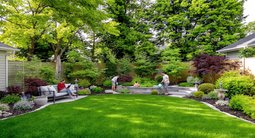
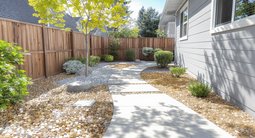
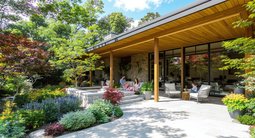
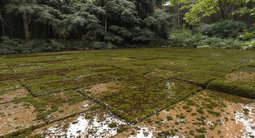
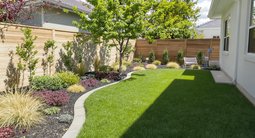
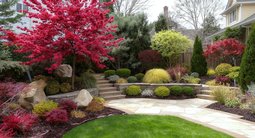





.png)